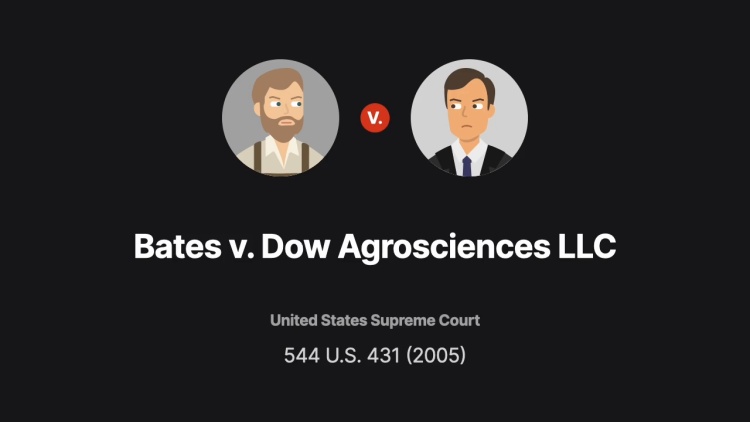Bates v. Dow Agrosciences LLC
United States Supreme Court
544 U.S. 431, 125 S.Ct. 1788, 161 L.Ed.2d 687 (2005)
- Written by Brian Meadors, JD
Facts
Dow Agrosciences LLC (defendant) made a weed killer named Strongarm. Strongarm was conditionally registered by the United States Environmental Protection Agency (EPA), giving Dow permission to sell Strongarm in the US. Strongarm’s label stated that “use of Strongarm is recommended in all areas where peanuts are grown.” However, using Strongarm in soil with a higher pH, like the soil in Texas, damaged the crops. Twenty-nine Texas peanut farmers (the farmers) (plaintiffs) who used Strongarm and suffered crop damage sued Dow. Bates brought several causes of action, many of them state common-law torts and actions under Texas’s deceptive-trade-practices act. Dow argued that the farmers’ suit could not go forward because the Federal Insecticide, Fungicide, and Rodenticide Act (FIFRA) preempted state-law claims. FIFRA § 136v(b) forbids states from imposing “requirements for labelling or packaging in addition to or different from those required [under FIFRA].” A federal district court found that FIFRA preempted the farmers’ claims against Dow, and a federal appellate court affirmed. The courts’ reasoning was that a common-law suit seeking damages for torts based on a FIFRA-registered label would have the practical effect of resulting in a label change. The courts concluded that such an effect was the equivalent of a label-changing requirement forbidden by FIFRA § 136v(b). The farmers appealed the case to the United States Supreme Court, which accepted the case for review.
Rule of Law
Issue
Holding and Reasoning (Stevens, J.)
Concurrence/Dissent (Thomas, J.)
What to do next…
Here's why 899,000 law students have relied on our case briefs:
- Written by law professors and practitioners, not other law students. 47,000 briefs, keyed to 994 casebooks. Top-notch customer support.
- The right amount of information, includes the facts, issues, rule of law, holding and reasoning, and any concurrences and dissents.
- Access in your classes, works on your mobile and tablet. Massive library of related video lessons and high quality multiple-choice questions.
- Easy to use, uniform format for every case brief. Written in plain English, not in legalese. Our briefs summarize and simplify; they don’t just repeat the court’s language.





